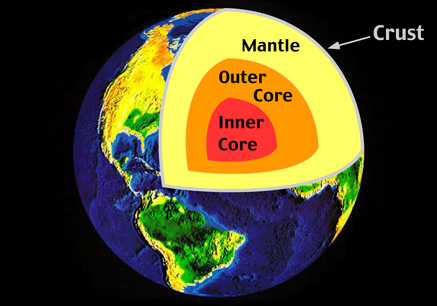EXPLORATION: Layers and Plate Tectonics
1. Layers of the Earth
How were Earth's layers discovered? What are they?
Earth's
interior is broadly grouped into three main layers on the basis of
chemical composition: crust, mantle, and core. An egg analogy is used to
show relative thicknesses, and a Big Hunk analogy illustrates how a
material of a single composition can be either brittle or ductile
depending on temperature. This animation shows briefly how scientists
figured out where these layers were, what the layers are, and how the
crust is often mistaken for the tectonic (aka lithospheric) plates.
Watch
the video below which explains the structure of Earth's layers as well
as the history of our understanding of this subject.
Keypoints:
- Layers were deduced by Sir Isaac Newton (1700) to Inge Lehmann (1937)
- Earth's three main layers: crust, mantle, core
- Layers are defined by composition
- Each layer has physical variations due to temperature and pressure
- The crust is only the upper part of the tectonic (lithospheric) plate.

Courtesy: Dr. Michael Pidwirny, Department of Geography, UBC Okanagan
- Lithosphere (Crust)
- 5 to 64 km thick
- brittle shell of solid rock that cracks, warps, and bends
- thinnest on the ocean floors
- Mesosphere (Mantle)
- approx. 2900 km thick
- upper part is known as the asthenosphere
- very hot, approx. 1650 deg. C in upper part
- pliable, semiplastic
- driving force for volcanoes, mountain building, and continental drift
- located in the upper mantle
- partially molten (i.e. approx. 10%)
- lithosphere "floats" on top of the asthenosphere
- zones that have become molten, or partially molten, can develop convection currents
- convection currents in the asthenosphere are responsible for plate movement(Note: Convection currents in the outer core are partially responsible for the earth's magnetic field but do not drive the tectonic plates)
- Core or Centrosphere
- approx. 2900 km thick
- Outer core: likely made of liquid iron
- Inner core: believed to be solid iron, 4000 to 6000 deg. C, inner heat believed to be caused by the decay of radioactive rock
Information
on this page from Incorporated Research Institutions for Seismology-
https://www.iris.edu/hq/inclass/animation/layers_of_the_earth